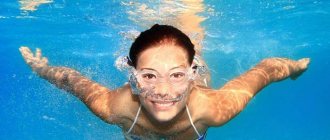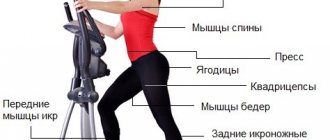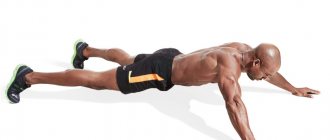Swimming for weight loss: hormones to help
Often, nutritionists, after correcting nutrition, recommend swimming for weight loss, since it replaces other types of cardio exercise, but is not inferior to them in effectiveness. Water makes exercise easier and enhances its effect, reduces stress on joints, and the possibility of injury is minimized. By stimulating blood circulation and the massage effect, fat is burned. Swimming reduces cortisol levels, a hormone that promotes fat storage.
During intense training in the pool, the thyroid hormone thyroxine is produced, which burns calories for several hours after exercise. Thanks to the aerobic exercise inherent in swimming, growth hormone (somatotropin) is produced, which promotes increased consumption of subcutaneous fat.
It is possible to lose weight using a swimming pool in 2-3 months, since swimming is one of the most energy-consuming sports. In water, the human body emits 50-80% more heat, as a result of which the metabolism in the body accelerates to restore losses.
Does pool water really interfere with weight loss?
One of the most authoritative specialists who studied biochemical processes in the body was Professor V.N. Seluyanov , whose work is continued by many of his students.
Professor Seluyanov V.N.
If you read his works, he quite convincingly explains that during physical activity it is not subcutaneous fat that is consumed, but glycogen in the muscles (as well as the existing supply of triglycerides in the blood obtained from food before exercise).
To greatly simplify and put it in simple terms, this is what happens:
- 1. During training , the body spends the glycogen available in the muscles (as well as the available energy reserve in the blood).
- 2. During rest (according to Seluyanov, primarily during sleep), the body restores glycogen reserves in the muscles. If you ate less calories in a day than you burned, the body will burn subcutaneous fat, driving triglycerides from it into the blood, and then from the blood into the muscles.
Many other modern experts adhere to the same point of view on metabolism in the body.
According to approximate calculations, the human body before training on average may have a reserve of glycogen in the muscles and glucose in the blood totaling 700-800 kcal (see, in particular: Kleiner Greenwood-Robinson. Sports nutrition for winners).
If a freestyle swimmer spends 350-400 kcal in 30 minutes of swimming , then you will have to continuously swim freestyle for an hour to use up the glycogen and glucose reserves available in the body, despite the fact that:
- a normal workout in the pool lasts about an hour, while also including a lighter warm-up and cool-down;
- If you are not a trained swimmer, then not only an hour, but even half an hour of continuous crawl swimming in the correct technique will be difficult for you.
Thus, during exercise in the pool, we are talking about burning a certain amount of glycogen in the muscles (if not all, then at least part of it) so that then, during rest, the body restores costs by burning existing fat .
From my point of view, it is difficult to assume that the narrowing of the capillaries in the area of subcutaneous fat has any significant significance in this case, unless we are talking about long-term exhausting training. I repeat, I have not found such criticism of swimming anywhere in sources citing scientific data.
A short video fragment from the speech of V.N. Seluyanova:
If you are interested in more detail in the point of view expressed by V.N. Seluyanov. in this video, its detailed analysis is carried out in the video and in the comments at this link (if you decide to read it, be sure to read the comments as well!).
General workout for weight loss
Swimming in a pool for weight loss is different from regular time in the water. Successful fight against excess weight is possible if you spend 80% of your time in the pool in motion and strictly follow the training plan.
The training program below combines calm swimming with interval training and helps to work all muscles. Exercises must be performed 3 times a week, alternating quiet exercises with interval training.
Before each workout, be sure to warm up
- Day 1. Swim at an average pace for 30 minutes without speeding up or stopping. Beginners need to start training with 5 minutes, gradually increasing the swimming time.
- Day 2. Warm up at an average pace for 5-10 minutes, one pool at the speed limit with crawl, then back with calm breaststroke. During the swim, monitor your heart rate; it should not exceed the normal rate by more than 60%. Repeat the cycle of fast and calm swimming 5-10 times. Complete your workout with calm swimming, 1-2 pools.
- Day 3. Warm up for 5-10 minutes, then move on to interval training as on the second day. When the body gets used to the new type of training, start increasing the load: swim 2-3 pools at a high pace and increase the number of cycles. Be sure to end your intense workout with a calm swim.
Swimming or running can bring both benefits and troubles. To find out exactly how to make this activity not only safe but also useful for yourself, click on the picture.
A set of exercises in the pool for weight loss
Walking
The simplest exercise that can be done by anyone is walking in place. This type of load is ideal for warming up. It loads the muscles well, warms them up, and prepares them for the upcoming complex. It is necessary to go into the water approximately up to your chest and perform leisurely movements, without moving from your place, slowly raising and lowering your legs.
You can combine walking with any exercise or swimming, or use it in interval training as a rest between sets.
Lunges
Lunges are a good exercise for strengthening your hips, back and chest muscles. The technique differs little from the “ground” one:
- enter the pool up to your waist;
- stretch your arms in front of you, you can take special light weight dumbbells or clasp them in front of your chest;
- make a deep lunge forward with your left leg, fix the position for 5-7 seconds;
- return to the starting position and repeat the exercise on the other leg.
To enhance the effect, you can attach weights to your ankles. The exercise is performed 15 times on each leg, 3-4 repetitions.
Jump
The “jump” exercise is an analogue of regular jumping in place. To do this you need:
- enter the pool approximately up to your chest;
- take a stable position;
- Gently rise up onto your toes. Do not make sudden movements, as you may slip and injure your ankle;
- bend your knees slightly, make a springy movement and push your body up;
- You need to land smoothly, placing your foot on your toes on your entire foot.
It is necessary to do at least 3 sets of 15-20 repetitions. This exercise helps strengthen the muscles of the thighs, buttocks, calves, and also improves coordination.
Run
Running is a replacement for walking, a more complex version of it. It is suitable for more prepared people who have already done several workouts in the pool.
The principle of implementation is quite simple:
- you need to enter the pool up to your chest and take a stable position;
- bend your arms at the elbows, hold them near the waist;
- With an inhalation, begin a leisurely run: slowly lower and plant your feet.
It is advisable to perform this exercise with weights. This will make it easier to float on the water, although the load will increase significantly.
Jumping
A more difficult option for performing the “jump” exercise is jumping. It has several different options:
- Jump alternately on each leg.
- Jumping on both legs.
- Jump up, and when returning, you need to spread your legs as wide as possible, making a light squat.
To perform it, you also need to go into the water up to your chest, make movements slowly, gradually increasing the speed and pace.
Tilts
The “bending” exercise is probably familiar to everyone from school or even kindergarten. From a standing position, you need to do twists forward, left, right, back, at least 10-15 repetitions on each side.
Bending helps strengthen the muscles of the back, abdomen, waist and sides, which is especially suitable for women for recovery after pregnancy.
Leg raises
This is the simplest, yet quite effective exercise for those who want to strengthen muscles and increase muscle tone. To complete it you need:
- enter the pool approximately up to your chest;
- your feet should be firmly on the bottom; for better balance, you can attach weights to your ankles or take a special plastic stick;
- stand up straight, spread your legs wide to the sides;
- raise your legs alternately as high as possible to the surface of the water.
You need to perform the exercise slowly, for 2-3 minutes, raising and lowering your leg as slowly as possible: it will be more difficult to do this, but the effect will be more noticeable.
How to swim to lose weight on your arms
Swimming as a way to lose weight in your arms deserves special attention.
Breaststroke is a swimming style in which the arms make intense strokes from the chest. With each movement, the hands push the water to the sides, overcoming its resistance. To lose weight, you can swim breaststroke one pool (25 meters) quickly, then one pool at a calm pace. In this mode, work 10 repetitions per workout. If the pool is 50 meters, then 5 repetitions.
When swimming crawl, the arms work more intensely than, for example, in breaststroke. To achieve the best result, it will be effective to alternate the crawl and breaststroke.
To increase the load on the arm muscles, use the shoulder blades.
The kolobaska can be used to “turn off” the legs, which will allow you to work only with your hands, thereby creating maximum load on the area you are working on. The horizontal position of the body is ensured by squeezing the bun between the legs.
How to learn to swim in a pool
Those who want to maintain a slim figure should learn how to properly learn to swim in a pool in order to lose weight. Learning to float requires only desire - skills can be acquired at any age. A pool for learning to swim is ideal - choose one with a shallow bottom so that you can feel the hard surface with your feet. It is better to study under the supervision of a trainer.
Losing weight in the pool requires swimming training, which consists of the following principles:
- Breathe correctly - inhale deeply through your mouth, exhale into the water. There is no need to fill your lungs completely - this interferes with movement. To practice, try while standing in the shallows, take a deep breath, dive completely under water and exhale through your mouth. Float above the water and breathe through your mouth - droplets from the nasopharynx can enter the lungs, causing suffocation. Breathing should be controlled by the strokes of the limbs.
- Staying on the water - the “star” exercise will help. Take a breath, lower your face into the water, spread your limbs to the sides in the shape of a star. Stay in the position as long as possible without exhaling. The same technique will help you overcome your fear of water.
- We teach the movements of the arms and legs - hold your socks outstretched, hit them hard on the water. The speed of movement depends on the speed of the blows. To train your legs, use support (the side of the pool, a floating object).
How to swim to lose belly fat
The crawl will help remove the belly and form elastic abs. The crawl forces the oblique muscles of the upper abs to work, due to which the fat layer is actively burned.
In order for the effect to be noticeable, it is necessary not only to swim crawl, but to do it correctly. The workout below is based on 12 weeks of regular training for beginners (three times a week):
- Week 1 – swim 200 meters during each workout.
- Week 2 – 300 meters.
- Weeks 3 and 4 – 400 meters each.
- Week 5 – first training 400 meters, the next – 500 meters.
- Weeks 6, 7 and 8 – 500 meters each workout.
- Weeks 9 and 10 – at the first training session, increase the distance to 600 meters, the next training sessions – 500 meters each.
- Weeks 11 and 12 – in the first training session the distance increases to 700 meters, in the next one it decreases to 500 meters.
IMPORTANT! Swimming with fins increases the load on the legs, resulting in active burning of fat in the waist and sides.
Before the swim, be sure to warm up for 5-10 minutes. This will help warm up the muscles and avoid possible injuries. To lose weight in the pool, swim in warm water. Cold water programs the body to retain heat by accumulating subcutaneous fat reserves.
Swimming pool - indications and contraindications
We looked at how swimming affects weight loss, but we said almost nothing about who is recommended for this sport, and who is extremely undesirable to practice in the pool.
Swimming is considered invaluable for work:
- of cardio-vascular system;
- brain (due to acceleration of nervous processes);
- gastrointestinal tract (peristalsis in the intestines becomes better);
- lungs (their volume becomes larger and their ventilation is better).
Swimming may be prescribed for medicinal purposes:
- disabled people suffering from mental and physical disabilities;
- persons with birth injuries;
- patients with cerebral palsy syndrome,
- persons suffering from autism;
- patients diagnosed with diseases of the musculoskeletal system;
- with rickets;
- with anemia.
Dosed swimming helps to cure diseases of the cardiovascular system such as ischemia, angina pectoris, myocarditis and neurosis.
Swimming in the pool is contraindicated:
- people with chronic diseases in their exacerbation phase or with infectious diseases.
- persons with malignant neoplasms.
- for skin diseases
- for eye diseases.
You should also not go to the pool if you have an open wound and (recommendation for women) on menstruation days.
How to swim to lose weight on your legs
The problem of subcutaneous fat and loose skin on the inner thigh can be solved by swimming breaststroke or butterfly.
When swimming breaststroke, the legs imitate the movements of frogs: they bend at the knees and push off from the water. With the help of breaststroke, it is easy to remove fat deposits and tighten the muscles of the legs, since pushing off the water in this style is carried out with the legs.
Butterfly is considered one of the most difficult and energy-consuming styles. When swimming butterfly, the muscles of the abs, buttocks and thighs are involved. The legs and pelvis make wave-like movements that imitate the movement of a dolphin's fin.
The benefits will be most noticeable if you alternate sets of butterfly and breaststroke during training. To lose weight in your legs, swim 4-5 swimming pools with breaststroke and the same number of butterfly strokes at each workout and this will allow you to tighten your legs and achieve harmony in just 2-3 months.
How to swim to lose weight in your buttocks
All types of swimming - crawl, breaststroke, butterfly - have a positive effect on the muscles of the thighs and buttocks. In all styles the footwork is intense. Water also serves as a kind of lymph massager, which helps get rid of cellulite. Use the interval training method below and you'll see results in no time.
For example, swim one pool crawl or breaststroke at the highest possible speed, and the second - calmly on your back. This approach will diversify the workout and also allow you to load the muscles alternately.
IMPORTANT! Using a kickboard will allow you to concentrate your swimming only on your legs.
Example of an exercise with a kickboard:
- Place the board in front of you and hold it on the water with your arms outstretched.
- Lie on your stomach and kick your feet into the water, imitating crawl swimming.
- Swim 100-200 meters every workout.
In this exercise, do not try to keep your head above the water all the time. On the contrary, lower it into the water for a long exhalation, and lift it only when you need to take a quick breath.
Water aerobics helps emphasize the effect of swimming. To lose weight in the buttocks area, you can use the following element of water aerobics: holding the side of the pool with your hands, take a horizontal position and perform movements with your feet as if riding a bicycle. Repeat the exercise up to a hundred times if possible, applying maximum effort.
Now you know How to swim to lose weight in your buttocks, all you need to do is start!
Effective Fat Burning Styles
The best option for you would be freestyle swimming, also known as freestyle.
This style is quite energy-intensive, but not as complex as, for example, butterfly.
If freestyle is also difficult for you, then start with backstroke, this method is similar to freestyle, but a little easier. There is also breaststroke, but many people don’t know what it looks like correctly, so it’s more like grandma’s style, when your head sticks out above the water and you slowly move your arms to the sides.
Thirdly, I advise you to use additional equipment , for example, shoulder blades. They add resistance to the stroke and you will have to put more effort into the stroke, therefore you will also burn more calories, which means that your sides will become less comprehensive.
You can also use planks, fins and much more. With this equipment you can create not only difficult, but also interesting and varied workouts.
How long should you swim to lose weight?
The answer to the question “How much should you swim to lose weight?” depends on many factors, BUT after 2 months you will notice the result!
Within 10 minutes you can get rid of:
- from 60 kcal – breaststroke.
- from 80 kcal – swimming on your back.
- from 100 kcal – crawl swimming.
- from 150 kcal – butterfly swimming.
To lose weight and tone your muscles, visit the pool 3-4 times a week for at least 45 minutes. After exercise, fast for an hour to allow your body to continue burning calories, but be sure to drink plenty of fluids.
Exercise for losing weight on legs and buttocks:
Will I have broad shoulders?
There is nothing to worry about! Working out in the pool 3-4 times a week for 45 minutes will allow you to lose weight and tone up your body, but will not change your skeleton in any way.
Women's fears become understandable when looking at famous champions. However, the statement that all female swimmers have broad shoulders and a masculine figure is true only if they train from an early age and with the goal of becoming a professional.
The body grows and develops until the age of 25, after which cartilage tissue is completely replaced by bone tissue, and significant changes to the skeleton are no longer possible. In the adult body, the action of growth hormone is aimed specifically at burning excess calories.
The professional confirms:
Just a little theory
There are a huge number of theories on the topic of weight loss, the description and analysis of which is beyond the scope of this article.
Almost all theories, however, are united by a common idea: in order to lose weight, the body must burn more calories than it takes in.
In this case, there is a lack of energy and our body is forced to make up for its lack using its “energy reserve” - fats.
In fact, all weight loss comes down to this:
- or try to eat fewer calories than you burn during the day;
- or try to spend more calories per day than you get from food.
Everything else - diet features, quantity and timing of meals, types of sports activity - are essentially different variations of the above principle.
If we think this way theoretically, then essentially any sport leads to weight loss, since it is aimed at burning calories.
For example, it is believed that even 1 hour of playing billiards consumes 180 kcal. In theory, you can lose weight while playing billiards!
Then why are there different points of view on the question of whether swimming helps you lose weight?
Drinking while exercising in the pool
It is a mistake to think that during active training in the pool there is no need to maintain the water-salt balance of the body. Intense swimming squeezes even more moisture out of the body than running in the fresh air or exercising in the gym.
To avoid heat stroke due to dehydration, you should drink while exercising in the pool. What is the best thing to consume for hydration? Choose any to your taste:
- Drinking or mineral water without gas at room temperature.
- Water with the addition of natural juice (30-50 ml of juice per 250-300 ml of water).
- Isotonic with L-carnitine.
Athletes are advised to drink a glass of water an hour before training, 1-2 sips immediately before the swim, and 300-400 grams immediately after completion.
Pros compared to other weight loss methods
Some researchers write that, in general, in terms of calorie expenditure, swimming and running are equal, or running even slightly wins (depending, again, on the intensity and speed). Other researchers write that both sports are inferior to strength training in the gym in terms of weight loss.
However, another fact often goes unnoticed: swimming is considered the most harmless sport for the body.
If runners subject their knee joints to shock loads , and gym goers put axial loads on the spine and have a risk of joint injuries, then swimming, on the contrary, entails a minimum of harm to the body and a maximum of benefits for the spine and joints .
Moreover, for people who are seriously overweight, swimming is essentially the only option . In case of high obesity, both running and a significant part of the exercises in the gym can harm the spine and joints.
The undoubted advantage of swimming is that it is practically the only type of physical activity in which almost all muscles, ligaments, and joints are affected and trained .
I wrote in more detail about the benefits of swimming and all its advantages here.











